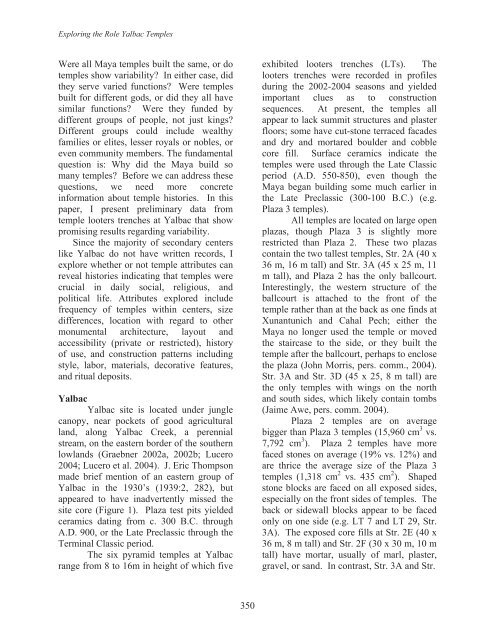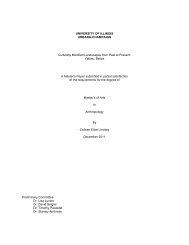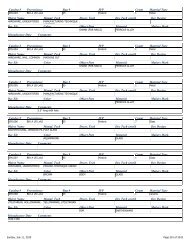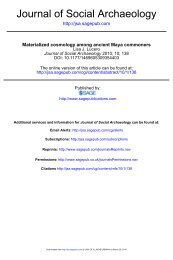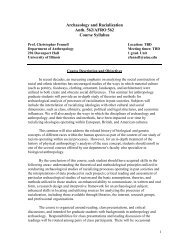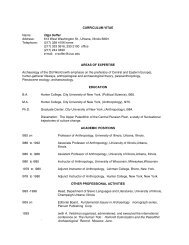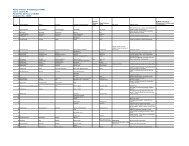2005 Exploring the Roles of Temples at Yalbac. Research Reports ...
2005 Exploring the Roles of Temples at Yalbac. Research Reports ...
2005 Exploring the Roles of Temples at Yalbac. Research Reports ...
You also want an ePaper? Increase the reach of your titles
YUMPU automatically turns print PDFs into web optimized ePapers that Google loves.
<strong>Exploring</strong> <strong>the</strong> Role <strong>Yalbac</strong> <strong>Temples</strong>Were all Maya temples built <strong>the</strong> same, or dotemples show variability? In ei<strong>the</strong>r case, did<strong>the</strong>y serve varied functions? Were templesbuilt for different gods, or did <strong>the</strong>y all havesimilar functions? Were <strong>the</strong>y funded bydifferent groups <strong>of</strong> people, not just kings?Different groups could include wealthyfamilies or elites, lesser royals or nobles, oreven community members. The fundamentalquestion is: Why did <strong>the</strong> Maya build somany temples? Before we can address <strong>the</strong>sequestions, we need more concreteinform<strong>at</strong>ion about temple histories. In thispaper, I present preliminary d<strong>at</strong>a fromtemple looters trenches <strong>at</strong> <strong>Yalbac</strong> th<strong>at</strong> showpromising results regarding variability.Since <strong>the</strong> majority <strong>of</strong> secondary centerslike <strong>Yalbac</strong> do not have written records, Iexplore whe<strong>the</strong>r or not temple <strong>at</strong>tributes canreveal histories indic<strong>at</strong>ing th<strong>at</strong> temples werecrucial in daily social, religious, andpolitical life. Attributes explored includefrequency <strong>of</strong> temples within centers, sizedifferences, loc<strong>at</strong>ion with regard to o<strong>the</strong>rmonumental architecture, layout andaccessibility (priv<strong>at</strong>e or restricted), history<strong>of</strong> use, and construction p<strong>at</strong>terns includingstyle, labor, m<strong>at</strong>erials, decor<strong>at</strong>ive fe<strong>at</strong>ures,and ritual deposits.<strong>Yalbac</strong><strong>Yalbac</strong> site is loc<strong>at</strong>ed under junglecanopy, near pockets <strong>of</strong> good agriculturalland, along <strong>Yalbac</strong> Creek, a perennialstream, on <strong>the</strong> eastern border <strong>of</strong> <strong>the</strong> sou<strong>the</strong>rnlowlands (Graebner 2002a, 2002b; Lucero2004; Lucero et al. 2004). J. Eric Thompsonmade brief mention <strong>of</strong> an eastern group <strong>of</strong><strong>Yalbac</strong> in <strong>the</strong> 1930’s (1939:2, 282), butappeared to have inadvertently missed <strong>the</strong>site core (Figure 1). Plaza test pits yieldedceramics d<strong>at</strong>ing from c. 300 B.C. throughA.D. 900, or <strong>the</strong> L<strong>at</strong>e Preclassic through <strong>the</strong>Terminal Classic period.The six pyramid temples <strong>at</strong> <strong>Yalbac</strong>range from 8 to 16m in height <strong>of</strong> which fiveexhibited looters trenches (LTs). Thelooters trenches were recorded in pr<strong>of</strong>ilesduring <strong>the</strong> 2002-2004 seasons and yieldedimportant clues as to constructionsequences. At present, <strong>the</strong> temples allappear to lack summit structures and plasterfloors; some have cut-stone terraced facadesand dry and mortared boulder and cobblecore fill. Surface ceramics indic<strong>at</strong>e <strong>the</strong>temples were used through <strong>the</strong> L<strong>at</strong>e Classicperiod (A.D. 550-850), even though <strong>the</strong>Maya began building some much earlier in<strong>the</strong> L<strong>at</strong>e Preclassic (300-100 B.C.) (e.g.Plaza 3 temples).All temples are loc<strong>at</strong>ed on large openplazas, though Plaza 3 is slightly morerestricted than Plaza 2. These two plazascontain <strong>the</strong> two tallest temples, Str. 2A (40 x36 m, 16 m tall) and Str. 3A (45 x 25 m, 11m tall), and Plaza 2 has <strong>the</strong> only ballcourt.Interestingly, <strong>the</strong> western structure <strong>of</strong> <strong>the</strong>ballcourt is <strong>at</strong>tached to <strong>the</strong> front <strong>of</strong> <strong>the</strong>temple ra<strong>the</strong>r than <strong>at</strong> <strong>the</strong> back as one finds <strong>at</strong>Xunantunich and Cahal Pech; ei<strong>the</strong>r <strong>the</strong>Maya no longer used <strong>the</strong> temple or moved<strong>the</strong> staircase to <strong>the</strong> side, or <strong>the</strong>y built <strong>the</strong>temple after <strong>the</strong> ballcourt, perhaps to enclose<strong>the</strong> plaza (John Morris, pers. comm., 2004).Str. 3A and Str. 3D (45 x 25, 8 m tall) are<strong>the</strong> only temples with wings on <strong>the</strong> northand south sides, which likely contain tombs(Jaime Awe, pers. comm. 2004).Plaza 2 temples are on averagebigger than Plaza 3 temples (15,960 cm 3 vs.7,792 cm 3 ). Plaza 2 temples have morefaced stones on average (19% vs. 12%) andare thrice <strong>the</strong> average size <strong>of</strong> <strong>the</strong> Plaza 3temples (1,318 cm 2 vs. 435 cm 2 ). Shapedstone blocks are faced on all exposed sides,especially on <strong>the</strong> front sides <strong>of</strong> temples. Theback or sidewall blocks appear to be facedonly on one side (e.g. LT 7 and LT 29, Str.3A). The exposed core fills <strong>at</strong> Str. 2E (40 x36 m, 8 m tall) and Str. 2F (30 x 30 m, 10 mtall) have mortar, usually <strong>of</strong> marl, plaster,gravel, or sand. In contrast, Str. 3A and Str.350


